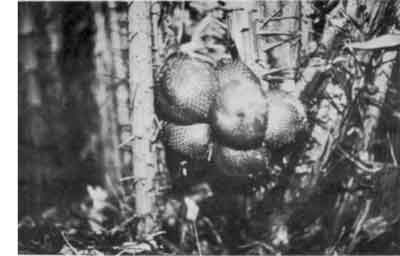From the Archives
of the Rare Fruit Council of Australia
by John
Marshall

The Salak Palm
Scientific
name: Salacca
zalacca, S. edulis
Family:
Arecaceae

Three
years ago we planted four salak palms in the garden without knowing
much about them; mainly just to add variety to our collection.
Since
then many of our exotics have turned out to be "good for making jam
only", but the salak has turned out to be a real winner.
Last
week we decided to clean around these terribly thorny, well-armed palms
and discovered a beautiful bunch of 6 ripe fruits. On further
examination, we found all the palms had bunches of fruit and several
emerging flower stalks. We also found several bunches of old dried
fruit with germinated seedlings inside. All the fruit were found within
12 inches (30 cm) of the ground.
After several photographs and
much excitement, one of the fruit fell off (or was pushed). The light
brown, scaly skin was easily removed by twisting and revealed a creamy
flesh divided into several odd-sized segments and one hard-shelled seed
(1 cm diameter) within the largest segment.
The consistency was
firm and crisp but not quite as firm as an apple. The flavour was
delicious, slightly sweet, and reminded me of pineapple flavour. Some
say it is more like carambola flavour.
Semi-shade is essential
for these palms, especially in the young stage. Tall banana varieties
are ideal for planting between salak palms and seem to provide the
right light-shade environment. Our salaks are shaded by the banana
variety Pisang Rajah and have fruited well while still under this shade.
The
salak appears to have a short, weak, root system and falls over easily
in windy conditions. The trunk has a habit of growing along the ground
continually regenerating as the trailing end disintegrates.
Seedling
salak palms 'sucker' a lot for the first few years and all, except one,
should be removed. Most suckers die when potted up. However, commercial
plantations in Indonesia are sometimes planted with suckers.
There are at least 14 varieties of salak in S.E. Asia and of these the
'Bali' variety appears to be the most popular.
William
F. Whitman of Florida reported many years ago that the 'Bali' salak was
monoecious whilst other salaks were dioecious. Since then we have had
many conflicting reports, including the story that Mr. Whitman did not
see the male trees growing around the perimeter of the salak orchards
he visited in Indonesia. However, individual salaks have now fruited in
North Queensland, thus proving Mr. Whitman correct in his observations.
Commercial
potential is as yet unknown, although they are commercial on a small
scale in S.E. Asia. At this stage, one can say only that salak should
be readily acceptable to Western tastes, and that one instantly
develops a liking for them.
Back to
Salak
Palm Page
|
|